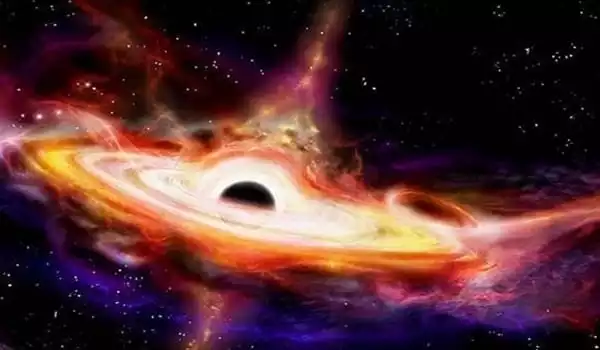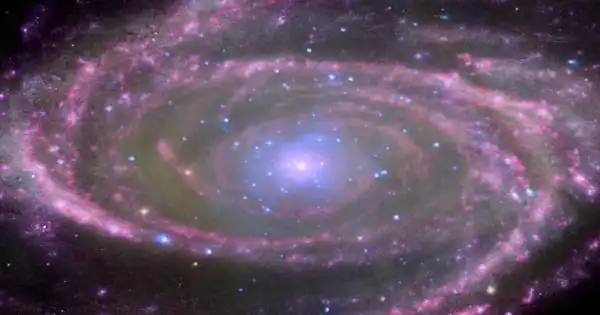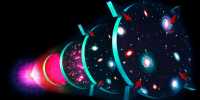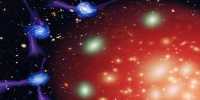According to the researchers, black hole feeding patterns provide information about their size. A new study found that the brightness flickering observed in actively feeding supermassive black holes is related to their mass.
Supermassive black holes are millions to billions of times more massive than the sun, and they are typically found at the center of massive galaxies. SMBHs emit very little light when dormant and not feeding on the gas and stars around them; the only way astronomers can detect them is through their gravitational influences on stars and gas in their vicinity. However, when SMBHs were rapidly growing in the early universe, they were actively feeding – or accreting – materials at high rates and emitting massive amounts of radiation, sometimes outshining the entire galaxy in which they resided, according to the researchers.
The new study, led by astronomy graduate student Colin Burke and professor Yue Shen at the University of Illinois Urbana-Champaign, discovered a definitive relationship between the mass of actively feeding SMBHs and the characteristic timescale in the light-flickering pattern. The research was published in the journal Science.
These findings imply that the processes underlying the flickering during accretion are universal, regardless of whether the central object is a supermassive black hole or a much more lightweight white dwarf.
Professor Yue Shen
The light observed from an accreting SMBH is not constant. It exhibits a ubiquitous flickering over timescales ranging from hours to decades due to unfathomable physical processes. “Many studies have been conducted to investigate possible relationships between observed flickering and the mass of the SMBH, but the results have been inconclusive and sometimes controversial,” Burke explained.
To study the variability pattern of flickering, the researchers compiled a large data set of actively feeding SMBHs. They discovered a distinct timescale over which the pattern changes, which is highly correlated with the mass of the SMBH. The researchers then compared the results to accreting white dwarfs, which are the remnants of stars like our sun, and discovered that the same timescale-mass relation holds true, despite the fact that white dwarfs are millions to billions of times less massive than SMBHs.
The light flickers are caused by random fluctuations in the feeding process of a black hole, according to the researchers. Astronomers can measure the power of the variability as a function of timescales to quantify this flickering pattern. The variability pattern of accreting SMBHs shifts from short to long timescales. This pattern transition occurs at a characteristic timescale that is longer for more massive black holes.

By equating this transition to a human belch, the team compared black hole feeding to our eating or drinking activity. Babies frequently burp while drinking milk, whereas adults can hold their burp for a longer period of time. They claimed that black holes do the same thing when they feed.
“These findings imply that the processes underlying the flickering during accretion are universal, regardless of whether the central object is a supermassive black hole or a much more lightweight white dwarf,” Shen said.
“The firm establishment of a link between the observed light flicker and fundamental properties of the accretor will undoubtedly help us better understand accretion processes,” said Yan-Fei Jiang, a Flatiron Institute researcher and study co-author.
Astrophysical black holes have a wide range of mass and size. Between the population of stellar-mass black holes, which weigh less than a few tens of times the mass of the sun, and the population of SMBHs, there is a population of intermediate-mass black holes, which weigh between 100 and 100,000 times the mass of the sun.
IMBHs are expected to form in large numbers throughout the universe’s history, and they may provide the seeds needed to grow into SMBHs later on. However, this population of IMBHs is surprisingly elusive in terms of observation. There is only one undeniably confirmed IMBH, which weighs approximately 150 times the mass of the sun. However, the IMBH was discovered by chance as a result of gravitational wave radiation from the merger of two less-massive black holes.
“Now that we know there’s a link between the flickering pattern and the mass of the central accreting object, we can use it to predict what the flickering signal from an IMBH might look like,” Burke explained.
Astronomers around the world are anticipating the official start of a new era of massive surveys that will monitor the dynamic and variable sky. Starting in late 2023, the Vera C. Rubin Observatory in Chile’s Legacy Survey of Space and Time will survey the sky for a decade and collect light flickering data for billions of objects.
“Mining the LSST data set to search for flickering patterns consistent with accreting IMBHs has the potential to discover and fully understand this long-sought mysterious population of black holes,” said co-author and University of Illinois astronomy professor Xin Liu.














